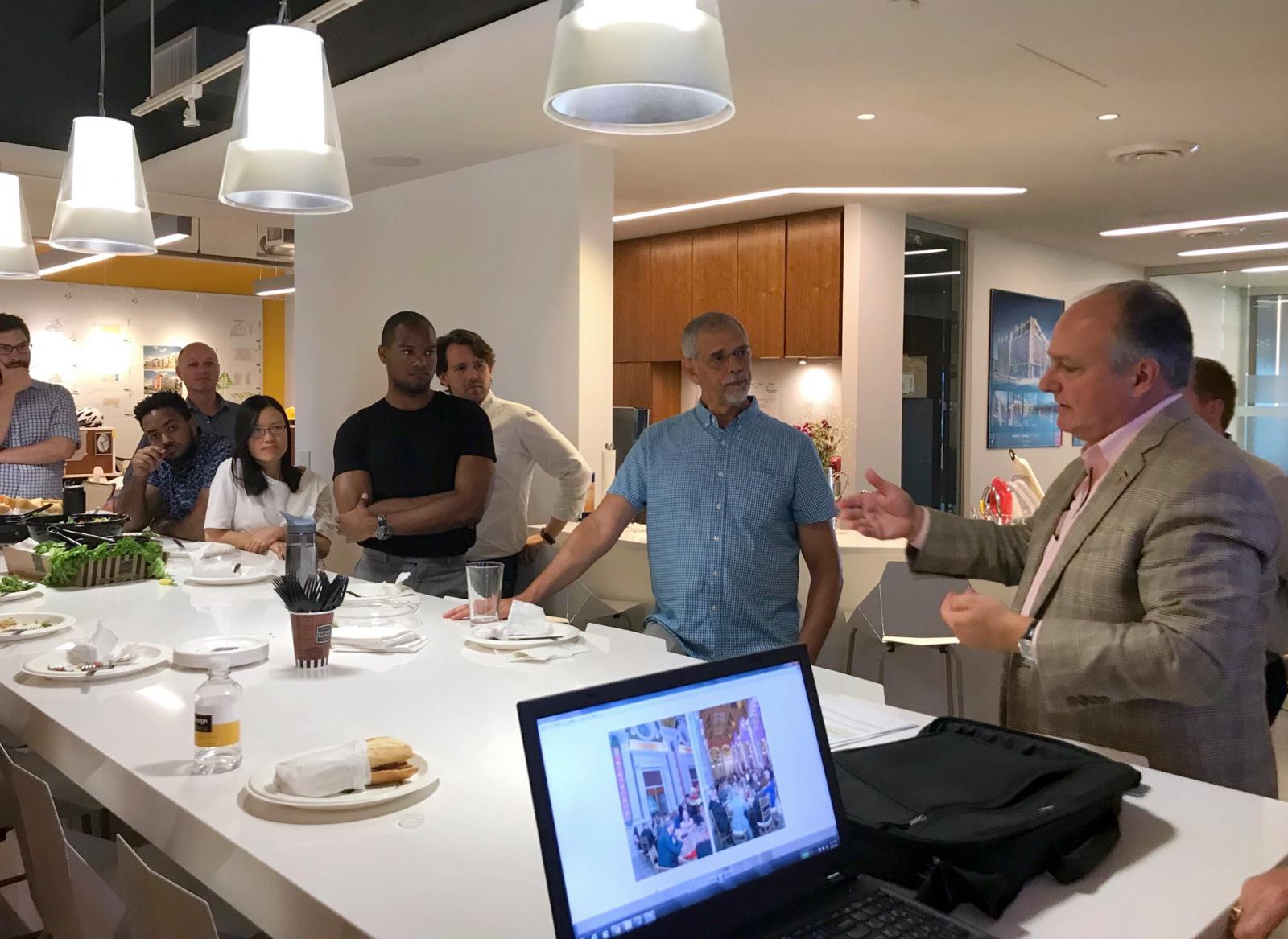When Bill Bonstra decided to open his own shop in 1999, he met good friend and former classmate Mike Solomon for lunch. As they toasted Bonstra’s new adventure, Solomon presented him with a gift: a book, entitled Professional Practice 101: A Compendium of Business and Management Strategies in Architecture.
“I have referred to the book often over the past 20 years,” recalls Bonstra, Principal of Washington, D.C. design firm Bonstra|Haresign ARCHITECTS, who keeps the book within arm’s reach of his desk.
So, it was akin to a celebrity sighting when, years later, Bonstra randomly sat next to the book’s author at a MAPP Board of Visitor’s meeting.
“We introduced ourselves and I thought, ‘I know that name,’” said Bonstra. “Then I exclaimed, ‘Wait! I have your book on my desk!’”
Twenty years after receiving Pressman’s book over a friendly lunch, it is a mandatory “pitstop” on Bonstra’s firm tour for architecture graduate students from Pressman’s class, ARCH 770: Professional Practice in Architecture.
Andrew Pressman didn’t just write the book on building a thriving architecture practice, he wrote eight of them. Well-versed in topics ranging from business fundamentals to client relationships, the accomplished designer and prolific author has taught Professional Practice of Architecture for the past 10 years at UMD. The course is an indoctrination for graduate students into real-world practice, fulfilling a myriad of required content prescribed by the National Architectural Accrediting Board: foundational aspects like marketing, ethics, operations, fees, hiring and pro bono work. But Pressman reframes many aspects of practice life by challenging students to apply design thinking–a human-centered design tool—beyond the drafting table. An increasingly used technique in the business of making buildings, design thinking, Pressman says, is a secret weapon for approaching virtually any problem with fresh thinking, and can be especially helpful in growing a successful professional career.
“Design thinking is a very powerful skill that our students have and can use to conjure inspirational perspectives to practice issues,” says Pressman. “If you frame day-to-day things—like securing commissions or hiring—as a design problem, it can shift the approach in an intriguing way.”
Helping students see the intrinsic links between design and practice, Pressman explains, can help them be more responsive to both the “art and science” of the profession and navigate a constantly-evolving environment. How students approach the dynamics of practice—whether it is relationships with colleagues or clients, how they attract new business or interactions they have with contractors—will drastically inform how they design.
“Clients are not just a necessary evil to get your building built, it’s about transcending that relationship to create a work of architecture,” says Pressman.
Pressman expects that his students come to his class knowing very little about how to navigate firm life, so he works to help them explore the soft skills that will buoy their success after they leave school. Discussions center around how stakeholder relationships can enrich designs, collaboration, teamwork and communication. He regularly enlists the expertise and perspective of alums like Bonstra and Tom Gallas of the Silver Spring-based firm Torti Gallas.
“The Professional Practice Course clarified the importance of creatively designing all aspects of business practice, client relationships and firm culture, as well as the built environment,” says architecture graduate student Juanita Li (’21). “I feel more prepared to evaluate different firms and communicate how I can be an asset to them while considering their culture and project team structure.”
Bonstra’s participation in Pressman’s course goes beyond the chance book connection. He remembers taking the course—which has been a staple in the Architecture Program for decades—from Frank Schlesinger as a student. He admits he might not have realized the importance then, but as an established practitioner, he stresses that understanding the business side is critical to being a successful architect.
“I encourage these students to take as many other classes as they can to prepare for the business of architecture, because that’s where you’ll be rewarded,” he says. “Most of us have to wear a lot of hats. It’s important to understand the business side to develop as leaders.”
While firm visits were tabled this fall, Pressman subbed in regular guest speakers, including a contractor to talk about construction costs or a lawyer to talk about AIA contracts. Bonstra offered a virtual tour of Bonstra | Harseign that included four younger employees on the call—all UMD grads—to connect with the students and talk about the different roles they play in the office.
“It helps students envision themselves in their shoes and understand that there’s a place for them, whatever they are good at,” says Bonstra, who frequently taps UMD’s Architecture Program for new hires. “For us, it’s indicative of how we give back to the profession and how we give back to the school.”

